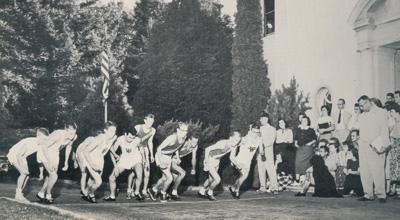历史:1950年代 回到1950年代
If you went back in time and met some Westmont students from the 1950s, they might not have time to talk to you. They’d be hurrying off to 图书馆 to study or to a meeting about a short missionary trip to Mexico. Perhaps they’d be packing for a retreat or trying to find tools to help with the construction of a new campus building. Even in the supposedly idyllic 1950s, Westmont students had busy lives.
Dating didn’t seem to be a popular pastime except as a topic of conversation. 1954年一封未署名的信哀叹道, “没有。, 我的意思是不, reason why so many of our women students should be dateless so often.另一封信问道, “Why is it that whenever a guy is seen more than three or four times with the same girl, 他很自然地, 在同学们的眼里, 关系稳定,实际上订婚了?还有一封信很有哲理. “Keep thine eyes open for social isolates of the feminine variety.”
Coming and going was a bit difficult, though. Women students signed in and out with their housemothers when leaving or returning to campus. Freshmen had to be in by 7:15 pm on week nights, but could stay out as late as midnight on weekends. 男人没有时间. But if a male student kept a date out late, both of them would be penalized. When a serious dating relationship developed and a couple decided to get married during the school year, they had to get permission from the dean of students at least 30 days before the wedding and present letters of permission from both sets of parents.
TWIRP (The Woman Is Required to Pay) eased the dating vacuum a bit. In this annual event, the women took the initiative and chose their own dates. 1954年11月12日的 地平线 记录激动. “Tonight is the thing that every coed has hoped for, planned for, and lost sleep over. Tonight each girl will escort the fellow she succeeded in trapping and tagging sometime since Wednesday noon to the biggest, most stupendous Women’s Open House in Westmont history.” These open houses involved the women asking (“trapping”), 举办, 开车, 娱乐, 并支付整个晚上的费用.
TWIRP, however, was the exception rather than the rule. 许多活动都不是男女同校的. Each fall the men and women parted ways for separate weekend retreats. Students heard sermons by a guest speaker, studied the Bible, and prayed together. The men also competed in an unofficial beard-growing contest.
The ladies’ campus club (Wives or Women Students) sponsored a reception for engaged women each year. 1956年春天, the topic of the WOWS’ spring event was, “The Woman’s Relationship to Her Husband, 家庭与儿童.” After the discussion, the women received booklets containing the WOWS’ favorite recipes.
The dorms bustled with activity – except during the early evening when quiet prevailed for studying. The women lived in Cold Spring Unit I (currently the Art Center) and Emerson, a house less than a mile from campus which is now a private residence. 这些人住在冷泉三单元, (now the 首页 of the English and modern language department) and Catherwood Hall (which burned down in 1964). “Q-ville” (a group of Quonset huts) sheltered a privileged few male students.
When they weren’t enjoying conversation by the fireplace in one of these residence halls, students liked to unwind in Kerrwood Lounge and gathered around the piano for sing-alongs after dinner. 晚上晚些时候, 灯熄灭后, women might hear the strains of “You Are My Sunshine” as a group of male students with a ukulele serenaded them outside their windows.
Ghost walks, games, and spooky stories made Halloween a favorite event. The traditional ghost walk extended through the gardens and paths of the campus. Students played games on Kerrwood Lawn, but the real action took place in Kerrwood Hall where students could test their bravery in the Haunted House. Or they could make their way to 图书馆 where a student read stories into the night.
Although Kerrwood Hall made a great Haunted House, the student body began to outgrow the building in the mid 1950s. It simply wasn’t big enough to hold classrooms, the administrative office of the College, 图书馆, and the offices for student organizations. 所以在1954年秋天, students decided to construct a building to house the offices of WCSA, 地平线, 和城堡.
Students oversaw “Operation Elbow Room” from raising money to the actual construction. They held a work week around Santa Barbara to raise money. The junior varsity basketball team and the faculty staged a basketball game with proceeds benefiting the project. Students even appeared on the local television station nine times to publicize fund-raising events. Almost all the 325 students on campus contributed in some way to Operation Elbow Room. Today that building houses the post office.
Students volunteered for a number of different ministries in the local community, 尤其是年轻的生命, 向高中生伸出援手. Through the years many Westmont graduates have joined Young Life as full-time staff members. This tradition continues in the 1990s as many current students lead Young Life groups.

